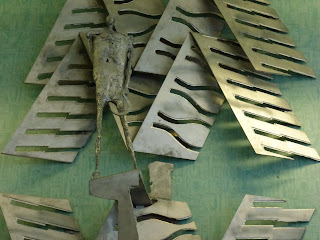The art staff began last Easter the task of building up six murals 2ft. 9in. wide and 22ft. 6in. high, in the assembly hall. The murals represent the culture of three continents. The two outside panels represent the Aztec culture of South America in the period of about 1600. The design is dominated by the sacrificial axes. The two centre panels represent Northern European culture around the ninth century and the inner panels represent African culture about the beginning of this century. The principal material used is copper, supplemented by brass and aluminium. The artificial stones set into the designs are of resin and coloured foil. A large part of the design of the African sections is formed by sapele wood which is indigenous to West Africa.
The panels were the idea of Mr Ian Stewart [architect of the school], a member of Fife county architect's department. He said: 'I had an idea what I wanted: I was after something barbaric. I discussed my ideas with the art staff and this is what they produced. I am more than satisfied'. The four members of staff who undertook the work were Mr Angus Scott, principal art master, Mr Donald Chisholm and Mr Arthur Edward and his wife Eleanor. Mr Scott said: 'Mr Stewart gave us more or less a free hand with the design and we put in 900 hours, not counting design time. We did all the work ourselves except that the pupils gave us some help with the preparation and the polishing of the materials.'
Fife Education Committee last month approved an ex gratia payment of £400 to the four teachers for their work on the murals, the money 'to be divided according to assessment of work done by each teacher'.
David Galloway, a former rector of the school, has noted in the Madras College archive that Scott, having spent time in Africa, created the African parts, Chisholm the 'Norse imagery' and the Edwards 'concerned themselves with South America and Asia'... He also suggests that the idea for the imagery was 'sparked off' by The Daily Express, which was apparently then running series of supplements on the arts of different cultures from around the world but that the artists were given complete freedom to design what they wished.
As the school building faces a very uncertain future, and hence the mural as well, the latter should be seen as a remarkable piece of its time, in keeping with the fifties-sixties movement for decorating schools in Scotland (and England) that I've written about already, and, in turn, being connected with the contemporary movement for 'motivational' and 'arresting' public art that artists such as Alasdair Gray were then vigorously moving forward [see Gray's book 'Lanark' and his mural work in Glasgow]. In fact, as one specialist in African art has told me:
'Your school [Kilrymont] is a blast. Homi Bhaba gives one total license. Is there some kind of Belgian Art Nouveau connection? On the third banner from the left, on the bottom, there is an extremely stylized interpretation of a Kota-speaking peoples' reliquary (Gabon). Every modernist coverted one of these and Picasso had several (poor quality). They are covered with brass and sometimes copper (as shown in the face). The hairstyle is unmistakable. But the artist has invented a dancer's body. Perhaps he imagined that it was some kind of mask instead of the decorative head for a reliquary basket? [JH - perhaps he was thinking of his school setting...] On the right hand group of three banners, on the left-most banner, there is a stool supported by a female caryatid figure with raised hands. This is clearly a highly stylized interpretation of a Luba stool (Democratic Republic of Congo/then Belgian Congo).... '
Angus Scott, the artist of these 'African' figures and a popular art teacher, died after suffering a brain haemorrhage, aged 45, in November 1970, just three years after completing the Kilrymont mural. May the mural survive as his tribute...
Five years after the Kilrymont mural was created the new Elmwood Agricultural and Technical College in Cupar, Fife, opened, this having an association with the St Andrews school through a day-release scheme. The brochure produced for the opening noted:
'Once in the building, the entrance foyer is given interest... by the mural sculpture in cast and wrought aluminium, signifying man's struggle with and eventual domination of his environment.'
The sculpture is no longer there. In 2003 it was moved upstairs to the library. A caption near it indicates that it is by Robert Sneddon and was commissioned by 'Fife County Council architect Jack Cowieson. The budget for the project was around £600. The theme of the sculpture is 'Organisation out of Chaos' with a subtheme of sowing and reaping... The background of the sower is designed in the shape of Africa, while the background of the reaper is furrow marks made by a plough.'
I have found nothing on Sneddon, nor any photographs of his sculptures in their original setting. I'd be very grateful for any information.

These artworks at Elmwood and Kilrymont connect with the contemporary educational architecture and culture of their time. More so than the Walter Scott (and his staghounds)
sculpture near the big redwood in the Elmwood grounds, or the 'Reflections of St Andrews' mural on the first floor landing at Kilrymont (by Susan Lerski and Craig Amy, 1995), which speak more 'realistically' of local and national heritage. All, however, speak of an aspiration to have art move and inspire youth during its institutionalised time of learning... And give food for further reflection...












No comments:
Post a Comment